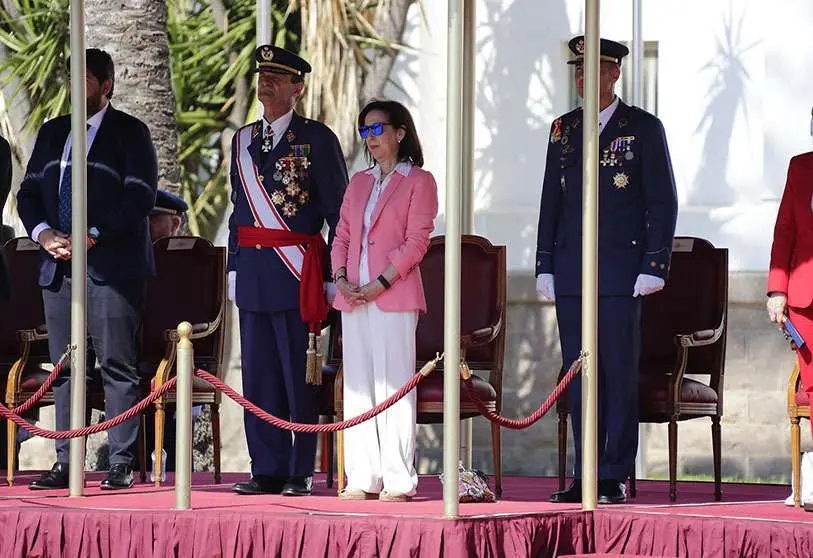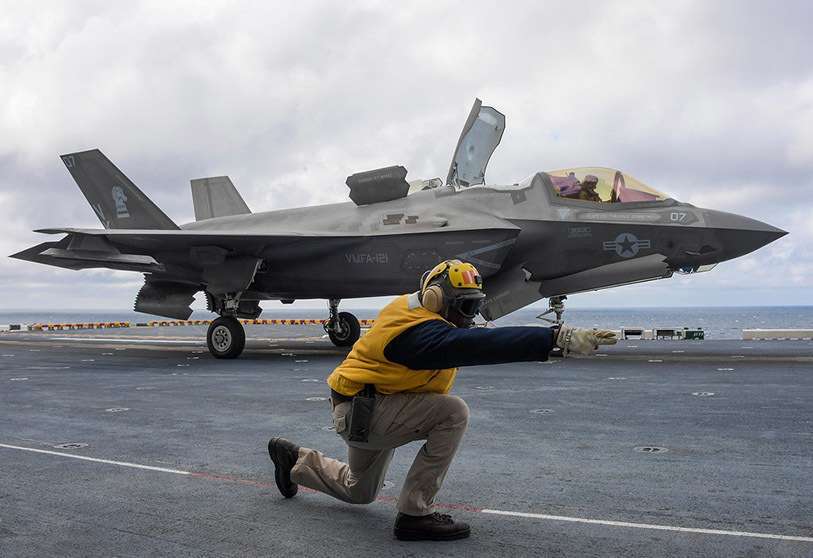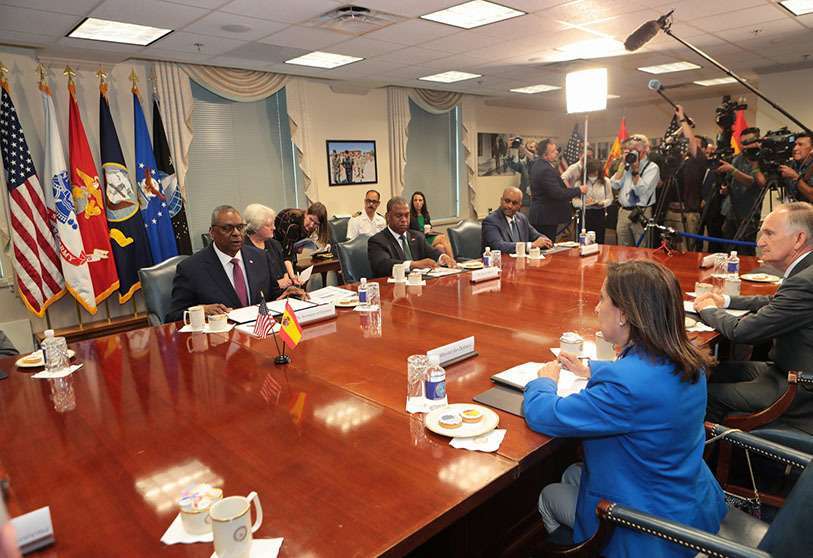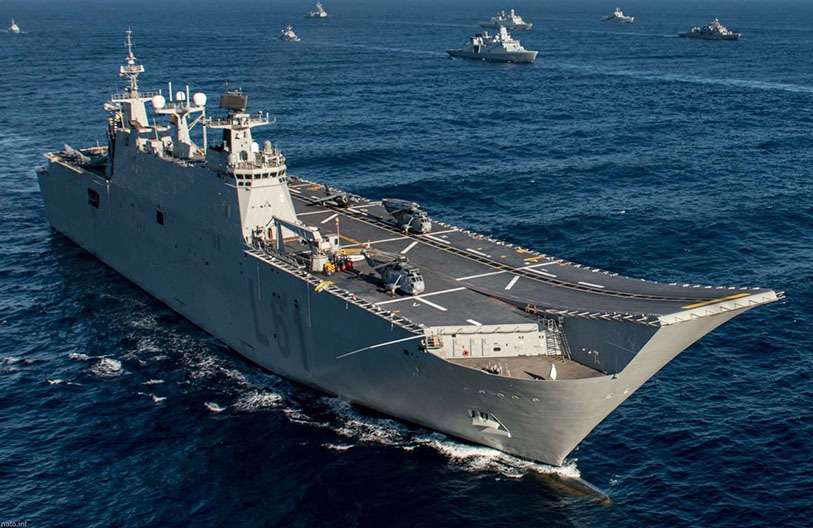Margarita Robles quietly finalises the purchase of F-35 fighter jets from the US

A small cell of the highest confidence of the Minister of Defence, Margarita Robles, has already finalised negotiations with the US Department of Defence and the Lockheed Martin industrial corporation for the purchase of the F-35, the fifth-generation stealth fighter of which more than 840 aircraft are already flying in the air forces of 17 nations.
With the express prior authorisation of the Prime Minister, Pedro Sánchez, the small Spanish team has sought counterparts with the US military-technical delegation and "have already agreed on the general outlines of the transaction," say sources familiar with the details. The Spanish Air Force needs to replace its more than 50 modernised F-18 fighters from the 12th Wing (Torrejón) and 15th Wing (Zaragoza) over the next decade. And the Navy needs to start replacing by 2029 its dozen veteran AV-8B Harrier II Plus that make up the 9th Squadron of its Aircraft Flotilla.
The start of the formal F-35 procurement process will be formalised in the coming months. A government-to-government agreement through the FMS (Foreign Military Sales) system is the mechanism by which Washington's defence department facilitates the sale of weapons systems, equipment, services and training to allied or friendly powers.

The total number of aircraft in Spanish demand is kept under lock and key. The aim is to obtain an initial batch of at least twenty F-35A aircraft for the Air Force and another dozen in F-35B vertical take-off configuration to renew the L-61 Juan Carlos I aircraft carrier's air projection potential. Once the contract is signed, the Spanish requests will enter the production line of the immense F-35 factory that Lockheed Martin has in Fort Worth, Texas, where thousands of orders are accumulating, making it practically impossible for the first units to arrive in Spain before 2030.
The Presidency of the Government and the Ministry of Defence are maintaining the utmost secrecy, to the point of blocking any information or public statement regarding the possibility of the F-35, even the mere reference to the aircraft by ministry officials. The announcement of the decision and the start of the administrative process for the purchase will take place "at the appropriate time", according to those who know the status of the matter but who, for obvious reasons, prefer to remain anonymous.

Among the reasons why Moncloa and Defence are keeping a strict silence and discretion with the already decided purchase is President Pedro Sánchez's order to avoid controversy with his government partners in Unidas Podemos and their parliamentary allies. The aim is to avoid hurting their delicate feelings and to prevent serious clashes that could wreck the 2023 State Budget and, later, blow up the fragile coalition.
The degree of obscurantism surrounding the F-35 has reached such an extreme that the Secretary of State for Defence, Amparo Valcarce, in her appearance on 20 October before the Congressional Defence Committee to present next year's Defence budgets, did not make the slightest allusion to the issue. She did not even mention the F-35 as an alternative, referring to the necessary replacement of half of the F-18s and all of the AV-8B Harrier II Plus.

Nor did he utter the words "Efe thirty-five" in response to requests for clarification from opposition members. The deputy for the Popular Group, Jesús Postigo, asked: "What is the truth of whether or not the government has committed itself to the purchase of F-35 fighters? Is this information correct? What is the decision of the Ministry of Defence? The F-35, the Eurofighter or the FCAS? The latter in reference to the future European combat aircraft that Germany, France and Spain have agreed to develop jointly and which has been at a standstill for many months.
The deputy of the VOX Group, Agustín Rosety, also asked for the Secretary of State's response to "the veiled procurement of the F-35 in version A and B for the Air Force and the Navy, which, by the way," he stressed, "she has not mentioned. Has it taken them so long to understand that it is the only possible replacement for the F-18 and the AV-8?
But Amparo Valcarce, like a bullfighter with years of experience in the profession, practised a "media verónica". A professional politician in the PSOE, before joining the Ministry of Defence in June 2018 as Director General of Education and Recruitment under her friend, Minister Margarita Robles, she was a member of Congress for three terms (between 1996 and 2008). In the government of José Luis Rodríguez Zapatero, a native of León like her, she was Secretary of State for Social Services, Families, Disability and Social Policy (2004-2009). She was then Government Delegate in Madrid (2009-2011) and later a member of the Madrid Assembly (2011-2015).

All that he responded to the clarifying remarks boiled down to the following: "The Armed Forces will choose the best replacement, have no doubt about it. There is no doubt in your minds that the armed forces and the government will choose the best replacement. But you have to let the Armed Forces work, you have to let them choose the best... it's in the defence planning and it's also budgeted for. And it will be done, of course it will". Olé, olé and Olé!
In the military sphere it is known that the purchase of the F-35B "is already more than underway". The F-35B is the only Western vertical take-off aircraft and therefore there is no alternative. The option of opting for second-hand AV-8B Harrier II Plus aircraft with thousands of flight hours under their belt, which the US Marine Corps is decommissioning, is not a solution for the Navy, despite the fact that the naval air base at Rota (Cádiz) maintains a large stock of spare parts. The geostrategic situation, more than ever, makes it advisable for the Navy to have new-generation aircraft with many decades of service ahead of them.

In the Air Force, the most vocal supporter of the F-35 is Air and Space Chief of Staff General Javier Salto. Both USAF officers and Lockheed Martin executives have been regulars at Air Force Headquarters and the Ministry of Defence, where they have made presentations, delivered reports of all kinds and answered questions. Even Spanish Air Force and Navy pilots have had the opportunity to get to know the F-35 in depth and fly it.
Defence budgets for the coming year include a heading entitled "replacement aircraft for the AV-8B and C-15M 2nd phase", which allocates 90 million for 2023 and 6.25 billion until 2028. Given that defence sources confirm that the ministry of "Finance allows us to transfer resources from one item to another, as long as it is for investment", the path to equipping the F-35 is practically assured from a financial point of view.

Spain and many other countries rely on at least two sources of supply for the weapons systems they consider critical. In the air and for the future, one is the European Eurofighter and the other, in the absence of a better solution, the F-35. Because the FCAS will reach beyond the year 2040, in their case. On 23 June last, Amparo Valcarve signed a purchase commitment in Berlin worth 2,043 million euros for 20 new Eurofighters in their most advanced version (tranche 4): 16 single-seat and 4 two-seat teaching aircraft. They will replace from 2026 the veteran Boeing F/A-18s of the 462nd Air Force Squadron stationed at the Gando air base (Gran Canaria). A solution has yet to be found for those at Zaragoza and Torrejón.
At a unit cost of between 80 and 100 million dollars, the F-35 stealth and multirole fighter in its A, B and C configurations is the most advanced fighter in the world. The US Air Force, Marine Corps and US Navy have signed up for more than 2,400 units, in addition to those committed or in advanced contracting stages by Australia (100), Belgium (34), South Korea (80), Denmark (27), Finland (64), Israel (75), Italy (90), Japan (147), Norway (52), the Netherlands (46), Poland (32), the United Kingdom (48), Switzerland (36) and Singapore. Germany has 35 devices.









